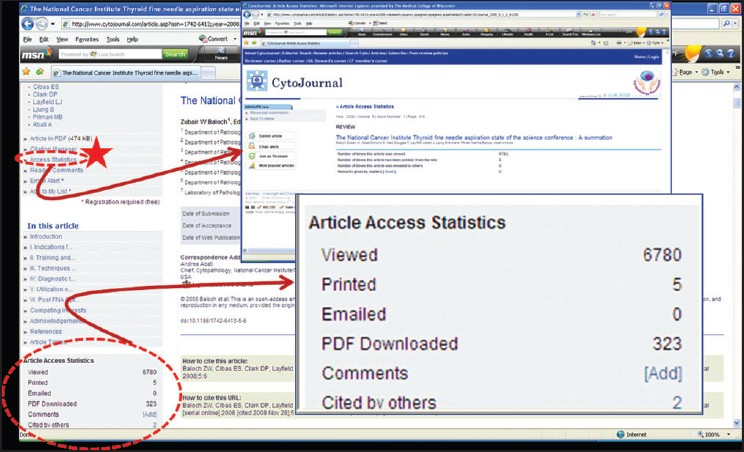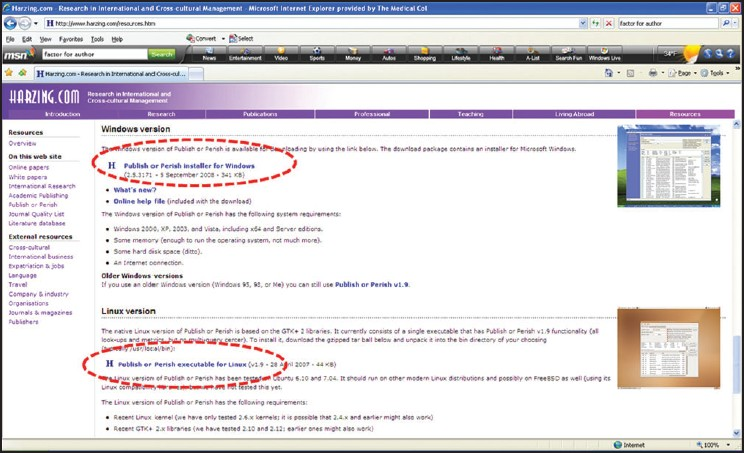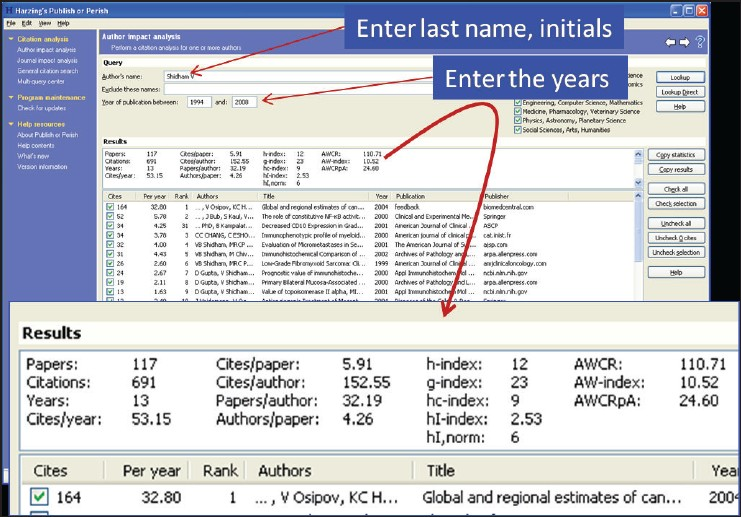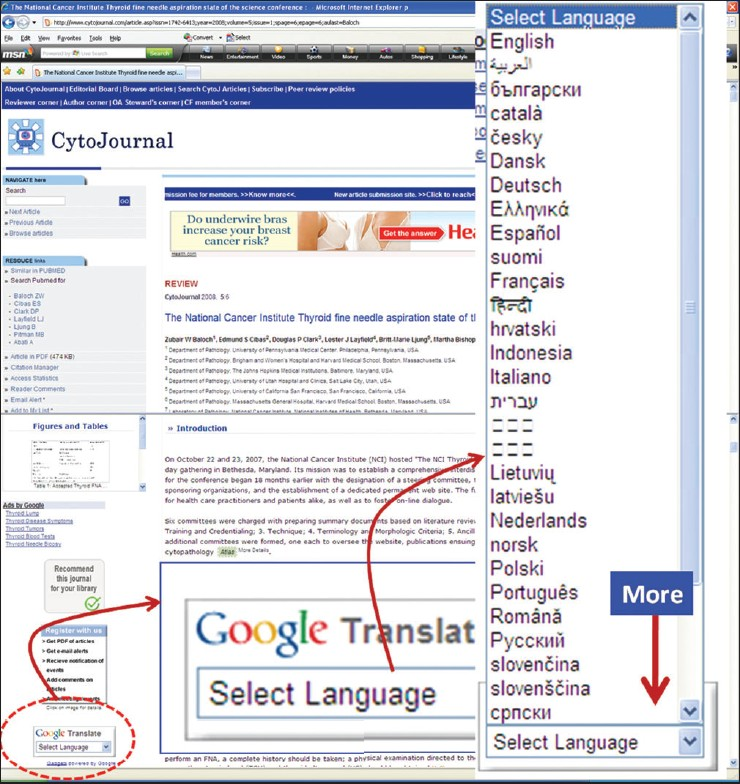Translate this page into:
CytoJournal's move to the new platform: More on financial model to the support open-access charter in cytopathology, publication quality indicators, and other issues
-
Received: ,
Accepted: ,
This is an Open Access article distributed under the terms of the Creative Commons Attribution License which permits unrestricted use, distribution, and reproduction in any medium, provided the original work is properly cited.
This article was originally published by Medknow Publications and was migrated to Scientific Scholar after the change of Publisher.
As discussed during the Nov, 2008 editorial board meeting (corresponding with the 56th Annual American Society of Cytopathology (ASC) Scientific Meeting at Orlando, FL, USA), CytoJournal has moved to a new platform (MedKnow Publications, http://www.medknow.com/). Currently most of the aspects of the move are complete. PDFs of all the articles published previously in CytoJournal before June 2008[1–86] will continue to be available on the new platform under the same URL of www.cytojournal.com (in the top blue bar, click on ‘Browse articles’ http://www.cytojournal.com/browse.asp) or click on ‘Search CytoJ Articles’ http://www.cytojournal.com/search.asp). They will also be available through other sites including PubMed (http://www.ncbi.nlm.nih.gov/PubMed/). All the articles published after the June, 2008 move would be available free under open access charter in HTML format. The PDFs will be available free to all Cytopathology Foundation members (http://www.cytojournal.com/CFMember.asp) and to the members of various organizations joining the ‘CytoJ OA steward’ program (http://www.cytojournal.com/OASteward.asp).
‘CYTOJOURNAL OPEN ACCESS STEWARD’ PROGRAM
In addition to the continued high standard of CytoJournal publication quality and the excellent online submission and online peer-review system, this platform offers many additional features. With the completion of this move to the new platform, Cytopathology Foundation Inc. (http://www.cytopathology-foundation.org/) (CF) and CytoJournal can extend numerous benefits of open-access charter in Cytopathology to encourage dissemination and sharing of scholarly Cytopathology literature. This is a significant benefit to Cytopathology as a science in particular and as information pool for evidence based information in general. As a result, the Cytopathology Foundation and CytoJournal have structured a ‘CytoJournal Open-Access Steward’ (CytoJ OA Steward) program.
Under the ‘CytoJ OA Steward’ program, individual member components of any organization, society, association, department, or institution can receive FREE benefits of open access just by endorsing the open access charter of Cytopathology Foundation AT NO COST. ‘CF open access charter’ supports free access to scholarly Cytopathology literature in CytoJournal without enforcing the flawed practice of copyright transfer on the authors. The CytoJournal authors in return agree to share the copyright under the Creative Commons Attribution License (http://creativecommons.org/licenses/by/2.0), which permits unrestricted use, distribution, and reproduction in any medium, provided the original work is properly cited.
EDITORIAL BOARD [Figure 1]
Because of an increase in the number of manuscript submissions, CytoJournal has updated and reorganized the editorial board, (http://www.cytojournal.com/eb.pdf) [Figure 1]. Some editorial board members who have expressed interest in contributing more time and efforts are identified as Associate Editors (AE). Designated AE of that month will complete the entire peer review cycle for all the manuscripts submitted during the corresponding month. The peer review cycle generally includes identifying qualified peer reviewers, inviting the qualified peer reviewers, and sending the manuscripts in a double blind fashion to the reviewers who have accepted the invitation. After reviewing the comments by various peer reviewers, the manuscripts would be processed further up to the stage of final evaluation by the AE. The final decision regarding acceptance or rejection would be communicated to the executive editor. Depending on the complexity of the manuscript subject matter and reviewer's criticisms, the executive editor may consult other editors in chief and the editorial board members as indicated to make the final decision of acceptance, re-revision, or rejection. After final acceptance, the manuscript is moved to the publisher for completing the publication process.

- Updated CytoJournal editorial board (http://www.cytojournal.com/eb.pdf)
The current editorial board with designated Associate Editors and other updates [Figure 1] are posted under ‘editorial board’ http://www.cytojournal.com/eb.pdf on the CytoJournal web site.
SELF SUSTAINING FINANCIAL MODEL FOR LONG-TERM STABILITY
CF membership program (http://www.cytojournal.com/CFMember.asp)
Cytopathology Foundation has introduced a very economical CF membership program http://www.cytojournal.com/CFMember.asp. This program is to establish a self-sustaining financial model with the opportunity for constituent beneficiaries of the open access charter in cytopathology to contribute to its long-term success. As most of the manuscripts would be published under the CF membership benefit, this model should nullify the perceived conflict of interest about the alternative of charging all the authors for the publication of accepted manuscripts. Although the regular annual membership fee is nominal ($50 per year), it is free during 2008 and 2009. The other option is a full membership at the low cost of $1,000 for life. Full membership has more benefits than the regular annual membership, with many more features to be added in the future.
CF members receive the following benefits:
-
Annual and full members: Free access to all PDFs in CytoJournal (otherwise $25 per download, HTML is free to all).
-
Receive FREE e-mail communications with electronic Table of Contents (e-TOC) of published CytoJournal articles at selected periodicity with links for PDF downloads.
-
Publish free in CytoJournal (if submitted manuscript is acceptable after double blind peer review). (Regular Article Publication Charge (APC) of $1500 is waived for CF members).
-
50% discount towards most of the Cytopathology Foundation publications including CytoJournal monographs and hard copy of CytoJournal.
-
Special access to ongoing programs including standing orders (for CytoJournal Monographs and paper edition of CytoJournal) with further decrease in the prices of various publications and services.
-
Other ongoing add-ons including CME on published material, on-line tests, blogs, on-line consultation club, webinars (online seminars), and other benefits. Full members have the option to certify as CF fellowship in Cytopathology after fulfilling internationally appropriate qualifying criteria including specific academic requirements and tests.
Information about the Article Publication Charge
For any enterprise to be self-sustaining, it is crucial to establish and execute a financially vibrant model. As mentioned at the beginning of this editorial, the new platform facilitates many of these features. One of the components of this model is contribution by the readers and authors as CF members for long-term financial stability and viability of CytoJournal. In addition to this avenue, the readers, authors, and other CytoJournal well-wishers are appealed to donate through online encrypted secure process with PayPal (click ‘Donate’ icon on left lower side of the CytoJournal home page www.cytojournal.com).
The authors who are not CF members or do not belong to ‘CytoJournal open-access steward’ program, still have the opportunity to get all the benefits of open access charter by paying a flat APC (Article Publication Charge) of $1,500 towards the publication expense in case the manuscript is accepted after completion of a double-blind peer-review process. This cost is comparable to and even lower than the current standard practice in ‘open access’ model of publication by other prominent publishers including non-profit entity such as Public Library of Science [PLoS] (http://www.plos.org/journals/pubfees.html) the Open Access Project at Public Knowledge and also commercial publisher such as BioMed Central (http://www.biomedcentral.com/info/authors/apcfaq#howmuch). The editorial activity of the CytoJournal will continue to be provided at no cost to all the authors for all the manuscripts- accepted or rejected.
The APC pays for many expenses mentioned below as a brief list (but not an exclusive).
-
Processing of raw manuscript for high-quality online publication in various formats.
-
Barrier-free, instant, global open access to the full text of the published manuscript with unprecedented exposure to the researcher's work.
-
Archival of the published articles in PubMed as soon as possible.
-
Organizing inclusion in CrossRef with [DOI ® http://www.doi.org/] (to facilitate electronic citation in other electronically available journals).
-
Developing, updating, and maintaining software for high quality of manuscript submission system.
-
Overall long-term self-sustenance of CytoJournal to support open access charter in Cytopathology.
The APC of $1,500 is significantly subsidized to $500 for the individual members of ‘CytoJ OA Steward’ (open to any department, institution, society, association, and other organizations endorsing Open Access charter of CytoJournal without any cost to the individual organization). For more details, please browse the CytoJournal website under different areas including CF membership benefits, CytoJ OA steward program benefits, etc.
INDICATORS TO ASSES AND COMPARE THE QUALITY OF PUBLICATIONS
CytoJournal, being an online journal, has many benefits of monitoring quality indicators in real time on its web site itself (http://www.cytojournal.com).
1. Most popular articles
The ten most popular articles are displayed by clicking on ‘Most popular articles’ on left hand side.
2. Article access statistics
Article access statistics for individual articles is available on line in real-time while reviewing each article in HTML (left hand side) [Figure 2].

- Article access statistics for individual articles in real-time
3. Other additional quality indicators
Other additional quality indicators, some in real-time as a FREE resource, are also available. CytoJournal falls in the range of other peer-reviewed Cytopathology scholarly journals and demonstrates indices corresponding with high quality.
Including Impact factor which is available through a commercial resource Thomson Reuters, http://thomsonreuters.com/about/ (previously ISI), there are many other quality indicators from a variety of third party open and FREE resources such as Google Scholar (http://scholar.google.co.uk/), SCImago research group (http://www.scimagojr.com/index.php), Index Copernicus (http://journals.indexcopernicus.com/masterlist.php?litera=aandstart=0andskok=30), and Harzing.com to mention a few.
3A. Commercially available quality indicators
Impact factor - Usually abbreviated as IF and provided by the commercial resource Thomson Reuters http://thomsonreuters.com/about/ previously called The Institute for Scientific Information ® (ISI ). It is one of the measures of the citations and historically had been the important indicator in the non-internet era. Although it has many limitations,[87] it is traditionally used as a tool to compare the importance of particular journal in a particular field.
IF is calculated from the data gathered over three-year period. It is calculated on the basis of the average number of citations (in year X for which IF is calculated) by all journals to those articles published in the two preceding years by journal ABC.[88]
For example, the 2008 IF of a journal ABC would be calculated as follows:
N = the number of citations during 2008 by various journals to all the articles published in 2006-7 by the journal ABC.
P = the number of "citable articles" published in 2006-7 by the journal ABC.
2008 impact factor for the journal ABC = N /P
(2008 IF would be available in 2009 as it could not be calculated until all of the 2008 publications had been considered.)
Although the official IF for CytoJournal will be available in near future, the roughly calculated unofficial impact factor [based on citation data from Google scholar http://scholar.google.co.uk/ using the above formula to calculate IF] is comparable to other Cytopathology journals.
3B. Real-time quality indicators available through FREE online open resources
As mentioned above, currently there are many other real-time, more flexible quality indicators allowing comparison between different journals in open system. These indicators not only provide quality evaluation of a particular journal, but also permit quantification of isolated articles and individual authors for comparative evaluation. The, department chairs-leaders, academic institutions, readers, and authors have FREE access to monitor and quantify individual articles, journals, and authors for promotion and other academic purposes.
i. h-index: Sometimes referred to as the Hirsch index or Hirsch number, quantifies scientific productivity and impact by the author. An author with an index of h has published h articles. Each of these h articles has been cited by other scholars at least h times (http://en.wikipedia.org/wiki/Hirsch_number#cite_note-2). This index is useful for comparing authors working in the same field as citation patterns differ widely among different fields. This index is ideal for promotion and comparison of different faculty in the same area of expertise.
ii. Index Copernicus (http://journals.indexcopernicus.com/info.php) provided through the freely available web site, which also explains how the index is generated (http://journals.indexcopernicus.com/info.php) with opportunity to compare with other journals from the data about other journals under the ‘Master List’ http://journals.indexcopernicus.com/masterlist.php?litera=aandstart=0andskok=30
iii. SCImago research group (http://www.scimagojr.com/index.php) has numerous features including SJR, H-index, and other quality indicators for comparison of various journals as a free resource.
iv. Harzing.com provides free software for citation analysis of individual authors and journals. To download this software visit http://www.harzing.com/resources.htm and click on ‘Publish or Perish installer for Windows’ (or for Linux) towards the bottom of this page by scrolling downward [Figure 3]. Citation analyses can be performed for individual authors [Figure 4] or journals [Figure 5] in 2 minutes based on online real-time Google scholar data http://scholar.google.co.uk/

- Free download of ‘Publish or perish’ software from Harzing.com http://www.harzing.com/resources.htm (Scroll to the bottom of the page)

- Author impact analysis performed with FREE ‘Publish or perish’ software

- Journal impact analysis performed with FREE ‘Publish or perish’ software
CYTOJOURNAL OPEN ACCESS ADVOCACY
CytoJournal strongly recommends that all the editorial board members, reviewers, authors, readers, and other well-wishers to participate in the ‘CytoJournal Advocacy’ and ‘CytoJ open access scholar’ program (http://www.cytojournal.com/cytooascholar.asp). An open access related poster/flyer may be downloaded from http://www.cytojournal.com/CytoJ-OpenAccess.pdf and e-mailed to your colleagues. Please post/circulate those in your department, institution, societies, and conferences, in order to communicate the benefits of this open access charter of CytoJournal. The current platform in addition to the very important feature of worldwide open access benefit has instant translation feature with translation into many languages around the world [Figure 6].

- Now the articles could be translated instantly in many languages around the world. Select the language by scrolling 'Google Translate' box on lower left hand side
We look forward to the continued support and active participation by all readers, authors, peer reviewers, and others considering the contents in CytoJournal as a resource of evidence based scientific literature. On behalf of CytoJournal, we thank Cytopathology Foundation Inc. (CF), its secretary/legal advisor Atty. John K. Bartosz, JD, LL.M (The Kingsbury Firm, LLC), and managing editor of CytoJournal- Anjani Shidham for their invaluable contribution of providing expertise in various activities of CytoJournal.
REFERENCES
- Use of the ThinPrep(R) Imaging System does not alter the frequency of interpreting Papanicolaou tests as atypical squamous cells of undetermined significance. CytoJournal. 2008;5:10.
- [Google Scholar]
- Calcium pyrophosphate dihydrate deposition disease (CPPD)/Pseudogout of the temporomandibular joint - FNA findings and microanalysis. CytoJournal. 2008;5:8.
- [Google Scholar]
- Myoepithelial cells: Any role in aspiration cytology smears of breast tumors? CytoJournal. 2008;5:9.
- [Google Scholar]
- Prevalence and significance of psammoma bodies in cervicovaginal smears in a cervical cancer screening program with emphasis on a case of primary bilateral ovarian psammocarcinoma. CytoJournal. 2008;5:7.
- [Google Scholar]
- The National Cancer Institute Thyroid fine needle aspiration state of the science conference: A summation. CytoJournal. 2008;5:6.
- [Google Scholar]
- A 5-year-old girl with a congenital ganglioneuroma diagnosed by fine needle aspiration biopsy: A case report. CytoJournal. 2008;5:5.
- [Google Scholar]
- Fine needle aspiration biopsy of intraoral and oropharyngeal mass lesions. CytoJournal. 2008;5:4.
- [Google Scholar]
- Comparison of Thin-Prep and cell block preparation for the evaluation of Thyroid epithelial lesions on fine needle aspiration biopsy. CytoJournal. 2008;5:3.
- [Google Scholar]
- Cytological and molecular diagnosis of solid variant of papillary thyroid carcinoma: A case report. CytoJournal. 2008;5:2.
- [Google Scholar]
- Utility of Thyroglobulin measurement in fine-needle aspiration biopsy specimens of lymph nodes in the diagnosis of recurrent thyroid carcinoma. CytoJournal. 2008;5:1.
- [Google Scholar]
- Scope of FNAC in the diagnosis of soft tissue tumors: A study from a tertiary cancer referral center in India. CytoJournal. 2007;4:20.
- [Google Scholar]
- Pathologist performed fine needle aspirations and implementation of JCAHO universal protocol and «Time out». CytoJournal. 2007;4:19.
- [Google Scholar]
- Desmoplastic melanoma morphology on Thinprep: A report of two cases. CytoJournal. 2007;4:18.
- [Google Scholar]
- Unsuspected multiples myeloma presenting as bilateral pleural effusion: A cytological diagnosis. CytoJournal. 2007;4:17.
- [Google Scholar]
- Barriers to adoption of recent technology in cervical screening. CytoJournal. 2007;4:16.
- [Google Scholar]
- Clear cell sarcoma of the soft parts arising in the rectus abdominis in a child-aspiration cytology of a rare case. CytoJournal. 2007;4:15.
- [Google Scholar]
- Nevoid melanoma of the vagina: Report of one case diagnosed on thin layer cytological preparations. CytoJournal. 2007;4:14.
- [Google Scholar]
- Immunohistochemical expression of SMAD4, CK19, and CA19-9 in fine needle aspiration samples of pancreatic adenocarcinoma: Utility and potential role. CytoJournal. 2007;4:13.
- [Google Scholar]
- Sequential use of bronchial aspirates, biopsies and washings in the preoperative management of lung cancers. CytoJournal. 2007;4:11.
- [Google Scholar]
- Lymphocytic thyroiditis: Is cytological grading significant? A correlation of grades with clinical, biochemical, ultrasonographic and radionuclide parameters. CytoJournal. 2007;4:10.
- [Google Scholar]
- Should fine needle aspiration biopsy be the first pathological investigation in the diagnosis of a bone lesion? An algorithmic approach with review of literature. CytoJournal. 2007;4:9.
- [Google Scholar]
- Book Review on “Modern uterine cytopathology: Moving to the molecular smear” by Alexander Meisels MD and Carol Morin, MSc, PhD. CytoJournal. 2007;4:8.
- [Google Scholar]
- Should LSIL with ASC-H (LSIL-H) in cervical smears be an independent category? A study on SurePath™ specimens with review of literature. CytoJournal. 2007;4:7.
- [Google Scholar]
- Introduction of the Thin Prep Imaging System™ (TIS): Experience in a high volume academic practice. CytoJournal. 2007;4:6.
- [Google Scholar]
- Solitary metastatic cancer to the thyroid: A report of five cases with fine-needle aspiration cytology. CytoJournal. 2007;4:5.
- [Google Scholar]
- Cytologic findings in malignant myoepithelioma: A case report and review of the literature. CytoJournal. 2007;4:3.
- [Google Scholar]
- Evaluation and significance of hyperchromatic crowded groups (HCG) in liquid-based paps. CytoJournal. 2007;4:2.
- [Google Scholar]
- Liver metastases of pancreatic acinar cell carcinoma with marked nuclear atypia and pleomorphism diagnosed by EUS FNA cytology: A case report with emphasis on FNA cytological findings. CytoJournal. 2006;3:29.
- [Google Scholar]
- Malignant atypical cell in urine cytology: A diagnostic dilemma. CytoJournal. 2006;3:28.
- [Google Scholar]
- Dynamic telecytopathology of onsite rapid cytology diagnoses for pancreatic carcinoma. CytoJournal. 2006;3:27.
- [Google Scholar]
- Atlas of salivary gland tumor cytopathology, Oral and surgical pathology - CD-ROM Disk 2. In: Kini S, Dardick I, eds. CytoJournal. Vol 3. Pathology Images Inc, 2006; 2006. p. :26.
- [Google Scholar]
- Rapid assessment of fine needle aspiration and the final diagnosis: How often and why the diagnoses are changed. CytoJournal. 2006;3:25.
- [Google Scholar]
- Combined applications of fine needle aspiration cytology and flow cytometric immunphenotyping for diagnosis and classification of non Hodgkin lymphoma. CytoJournal. 2006;3:24.
- [Google Scholar]
- Diffuse large B cell lymphoma of thyroid as a masquerader of anaplastic carcinoma of thyroid, diagnosed by FNA: A case report. CytoJournal. 2006;3:23.
- [Google Scholar]
- Alveolar proteinosis in a patient recovering from Pneumocystis carinii infection: A case report with a review of literature. CytoJournal. 2006;3:22.
- [Google Scholar]
- Biphasic parapharyngeal synovial sarcoma: A cytologic and immunocytologic report of a case. CytoJournal. 2006;3:20.
- [Google Scholar]
- Immunohistochemical detection of hTERT in urothelial lesions: A potential adjunct to urine cytology. CytoJournal. 2006;3:18.
- [Google Scholar]
- Cytodiagnosis of multiple myeloma presenting as orbital involvement: A case report. CytoJournal. 2006;3:19.
- [Google Scholar]
- Fine needle aspiration cytology of bone tumours--the experience from the National Orthopaedic and Lagos University Teaching Hospitals, Lagos, Nigeria. CytoJournal. 2006;3:16.
- [Google Scholar]
- ASC-H in Pap test--definitive categorization of cytomorphological spectrum. CytoJournal. 2006;3:14.
- [Google Scholar]
- High grade squamous intraepithelial lesion in inmates from Ohio: Cervical screening and biopsy follow-up. CytoJournal. 2006;3:15.
- [Google Scholar]
- T-cell lymphoproliferative disorder of hand-mirror cell morphology presenting in an eosinophilic loculated peritoneal effusion, with omental “caking”. CytoJournal. 2006;3:13.
- [Google Scholar]
- Fast drying of Fine Needle Aspiration slides using a hand held fan: Impact on turnaround time and staining quality. CytoJournal. 2006;3:12.
- [Google Scholar]
- Scientific issues related to the cytology proficiency testing regulations. CytoJournal. 2006;3:11.
- [Google Scholar]
- Utility of BRAF V600E mutation detection in cytologically indeterminate thyroid nodules. CytoJournal. 2006;3:10.
- [Google Scholar]
- Fine-needle aspiration of follicular lesions of the thyroid. Diagnosis and follow-Up. CytoJournal 2006:3-9.
- [Google Scholar]
- Sclerosing lobular hyperplasia of breast: Cytomorphologic and histomorphologic features: A case report. CytoJournal. 2006;3:8.
- [Google Scholar]
- Ultrasound guided fine needle aspiration biopsy of parathyroid gland and lesions. CytoJournal. 2006;3:6.
- [Google Scholar]
- First CytoJournal Peer-Reviewer's Retreat in 2006 - Open access, peer-review, and impact factor. CytoJournal. 2006;3:5.
- [Google Scholar]
- Randomized clinical evaluation of self-screening for anal cancer precursors in men who have sex with men. CytoJournal. 2006;3:4.
- [Google Scholar]
- Cytologic findings of peripheral T-cell lymphoma (PTCL) with high epitheloid cell content (Lennert's lymphoma) in imprint smear: A case report. CytoJournal. 2006;3:3.
- [Google Scholar]
- Hairy cell leukemia: A diagnosis by endoscopic ultrasound guided fine needle aspiration. CytoJournal. 2006;3:1.
- [Google Scholar]
- Primary fallopian tubal transitional cell carcinoma with exfoliation of malignant cells in cervical Pap smear. CytoJournal. 2005;2:20.
- [Google Scholar]
- Fine needle aspiration cytology of primary thyroid lymphoma: A report of ten cases. CytoJournal. 2005;2:21.
- [Google Scholar]
- Fine needle aspiration diagnosis of extracranial glioblastoma multiforme: Case report and review of the literature. CytoJournal. 2005;2:19.
- [Google Scholar]
- Primary small cell neuroendocrine carcinoma of the urinary bladder with coexisting high-grade urothelial carcinoma: A case report and a review of the literature. CytoJournal. 2005;2:18.
- [Google Scholar]
- Disseminated primary diffuse leptomeningeal gliomatosis: A case report with liquid based and conventional smear cytology. CytoJournal. 2005;2:16.
- [Google Scholar]
- Fine needle aspiration biopsy diagnosis of metastatic neoplasms of the breast: A three-case report. CytoJournal. 2005;2:17.
- [Google Scholar]
- Efficiency of an inexpensive liquid-based cytology performed by cytocentrifugations: A comparative study using the histology as reference standard. CytoJournal. 2005;2:15.
- [Google Scholar]
- Is an increase in CD4/CD8 T-cell ratio in lymph node fine needle aspiration helpful for diagnosing Hodgkin lymphoma? A study of lymph node FNAs with increased CD/CD ratio. CytoJournal 2005:2-14.
- [Google Scholar]
- Diagnostic utility of p16 immunocytochemistry for Trichomonas in urine cytology. CytoJournal. 2005;2:11.
- [Google Scholar]
- Review of «Fine needle aspiration cytology of the liver: Diagnostic algorithm a southeast asian perspective» by A Wee and P Sampatankul. CytoJournal. 2005;2:10.
- [Google Scholar]
- FNAB cytology of extra-cranial metastasis of glioblastoma multiforme may resemble a lung primary: A diagnostic pitfall. CytoJournal. 2005;2:9.
- [Google Scholar]
- Fine needle aspiration biopsy of the liver: Algorithmic approach and current issues in the diagnosis of hepatocellular carcinoma. CytoJournal. 2005;2:7.
- [Google Scholar]
- Preoperative diagnosis of a mediastinal granular cell tumor by EUS-FNA: A case report and review of the literature. CytoJournal. 2005;2:8.
- [Google Scholar]
- Desmoplastic small round cell tumour: Cytological and immunocytochemical features. CytoJournal. 2005;2:6.
- [Google Scholar]
- The Anal Pap smear: Cytomorphology of squamous intraepithelial lesions. CytoJournal. 2005;2:4.
- [Google Scholar]
- Remembering George L Wied, MD, February 7, 1921-July 25, 2004. CytoJournal. 2005;2:2.
- [Google Scholar]
- Desmoplastic infantile ganglioglioma: Cytologic findings and differential diagnosis on aspiration material. CytoJournal. 2005;2:1.
- [Google Scholar]
- FNAC of Bacillus- Calmette-Guerin lymphadenitis masquerading as Langerhans cell histiocytosis. CytoJournal. 2004;1:6.
- [Google Scholar]
- Merkel cell carcinoma in a malignant pleural effusion: Case report. CytoJournal. 2004;1:5.
- [Google Scholar]
- Second edition of ‘The Bethesda System for reporting cervical cytology’ - Atlas, website, and Bethesda interobserver reproducibility project. CytoJournal. 2004;1:4.
- [Google Scholar]
- Optimization of an immunostaining protocol for the rapid intraoperative evaluation of melanoma sentinel lymph node imprint smears with the ‘MCW melanoma cocktail’. CytoJournal. 2004;1:2.
- [Google Scholar]
- The agony and the ecstasy- The history and meaning of the journal impact factor. International congress on peer review and biomedical publication, Chicago. Available from: http://garfield.library.upenn.edu/papers/jifchicago2005.pdf; http://thomsonreuters.com/business_units/scientific/free/essays/about-jif/
- [Google Scholar]
- The thomson scientific impact factor. Available from: http://www.thomsonreuters.com/business_units/scientific/free/essays/impactfactor/ This essay was originally published in the Current Contents print editions June 20, 1994, when Thomson Scientific was known as The Institute for Scientific Information® (ISI®)
- [Google Scholar]







